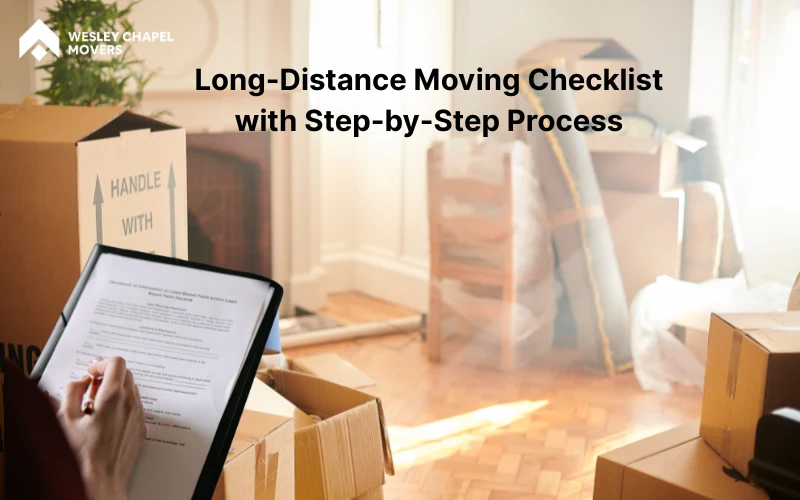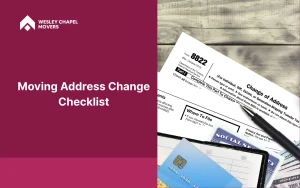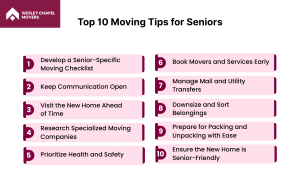Relocating over 400 miles to a new city or state can be both an exciting and overwhelming experience. With the need to coordinate everything from moving your belongings and arranging travel to setting up utilities and finding a trusted moving company, the process is complex and time-consuming. Without a clear plan, it can lead to last-minute stress and costly mistakes. A long-distance moving checklist is an essential tool, providing the structure needed to keep you organized and ensure that all important steps are completed on time.
A long-distance moving checklist serves as a step-by-step guide, breaking down the move into manageable, time-based tasks. By following a weekly breakdown of responsibilities, such as hiring movers, decluttering, scheduling utility transfers, and notifying the post office, you will stay on track and avoid feeling overwhelmed. With each task clearly outlined and prioritized, the checklist helps reduce stress, keeps you on schedule, and ensures a smooth transition to your new home. By following this structured plan, you will complete your move with confidence, knowing that everything is taken care of.
What is a Long-Distance Moving Checklist?
A long-distance moving checklist is a time-based tool that organizes and manages every task involved in a move over 400 miles. These moves require detailed planning due to factors like multiple logistics, time zones, and service providers. The checklist breaks the process into manageable steps with specific deadlines, ensuring tasks like hiring movers, packing, scheduling utility transfers, and notifying the post office are completed on time.
In addition to keeping you organized, a long-distance moving checklist is crucial for staying compliant with legal requirements, such as obtaining permits for large items or interstate moves. It helps both residential and commercial movers avoid the chaos of large relocations, ensuring a smooth, timely, and stress-free transition to your new home or office.
Why is a Long-Distance Moving Checklist Important?
A long-distance moving checklist is important to stay organized, reduce stress, meet deadlines, and prevent last-minute rushes during a move over 400 miles. It helps ensure tasks like hiring movers, packing, and transferring utilities are completed on time, keeping everything on track and within budget. By breaking down the process into manageable steps, the checklist minimizes oversights and ensures a smooth transition to your new home.
Here are the key benefits of using a long-distance moving checklist:
Staying Organized
Using a moving checklist is key to staying organized during a long-distance move. It breaks down the process into manageable phases, helping prioritize tasks and ensuring each step is completed on time. This approach reduces clutter, keeps everything on track, and avoids oversights, making the move more efficient.
Reducing Stress
Having a checklist in place significantly reduces stress by providing a clear plan for the entire process. It eliminates uncertainty and allows you to focus on one task at a time. By following the checklist, you can avoid surprises and maintain control, making the move less stressful.
Meeting Deadlines
To ensure deadlines are met, a checklist helps break tasks into manageable steps. By prioritizing critical tasks like utility transfers and travel plans, it ensures everything is done on time. This structure keeps you on schedule, preventing delays and making the entire move more timely and efficient.
Preventing Last-Minute Rushes
Avoiding last-minute rushes is possible with a checklist, which spreads tasks over time. It gives you the opportunity to complete each step without rushing, helping you stay ahead of the process. Early planning through the checklist prevents panic in the final stages, ensuring a smoother move.
Staying Within Budget
A checklist ensures you stay within budget by tracking expenses from moving fees to packing materials. It provides a clear overview of costs, helping you manage finances effectively. By staying organized, the checklist helps avoid unexpected expenses and keeps you on track financially.
Avoiding Oversights
Oversights are minimized with a checklist, which ensures that no task is forgotten. It keeps everything visible and organized, from canceling utilities to forwarding mail, reducing the chance of missing critical steps. This makes the move more efficient and helps avoid unnecessary complications.
Ensuring a Smooth Transition
A checklist ensures a smooth transition by planning key tasks like organizing essentials and setting up utilities in advance. It provides structure, ensuring the move-in process is well-organized. This makes adjusting to your new home easier and reduces post-move stress.
Step-by-Step Process for a Long-Distance Move
A step-by-step process is essential for managing a long-distance move, starting 8 weeks before the move and breaking down the process into manageable phases. This approach helps reduce stress and ensures that no important tasks are overlooked. Each week focuses on specific responsibilities, such as hiring movers, packing, and coordinating utility transfers, leading up to the moving day and post-move setup. By following this structured plan, everything is completed on time, making the entire process more organized and less overwhelming.
8 Weeks Before Move
Research and Hire a Reputable Moving Company
Research and hire a reputable moving company early. Compare reviews, get multiple quotes, and ensure the company is licensed and insured. This guarantees a secure and smooth move.
Get Multiple Quotes and Compare Services
Obtain multiple quotes to ensure competitive pricing and quality. Compare the services, distance, and insurance offered to find the best value for your needs.
Review Moving Contracts and Insurance Options
Review the moving contract thoroughly, focusing on hidden fees and insurance options. Ensure you have adequate coverage for your items, especially valuables.
Begin Decluttering and Sorting Items to Reduce Load
Start decluttering by sorting items into “keep,” “donate,” and “discard” categories. This reduces the load and makes packing easier and more cost-effective.
Create a Moving Binder to Store All Documents
Create a moving binder to store contracts, receipts, and moving-related documents. This keeps all important paperwork organized and easily accessible throughout the process.
Request Leave from Office for Moving Dates (If Needed)
Request time off from work well in advance. Coordinate with your supervisor or HR to ensure there are no conflicts with your move.
Inform Your Landlord About the Move-Out Date (If Renting)
Inform your landlord of your move-out date as soon as possible, providing written notice. Confirm move-out procedures and security deposit terms to avoid last-minute issues.
6 Weeks Before Move
Notify Utility Companies (Electric, Water, Internet) About Move-Out Date
Notify utility companies early to transfer or cancel services, as many require a 30-day notice. This avoids overlap charges or continued service at the old address and ensures no disruptions during the move.
Arrange for Temporary Storage If Needed
If necessary, arrange temporary storage for items that can’t be moved immediately. Consider options like self-storage or storage pods. Securing storage early prevents last-minute stress and delays.
Update Address with the Post Office, USMS, and Other Relevant Institutions
Update your address with the post office, banks, and other relevant institutions. USPS offers mail forwarding to your new address, ensuring you don’t miss important documents like bills and tax forms.
Disassemble Large Furniture (Bed, Shelves, Tables)
Disassemble large furniture early to save space and prevent damage. Keep small parts like screws in ziplock bags or taped to the furniture for easy reassembly.
Start Packing Non-Essential Items (Seasonal Clothes, Books, Decor)
Start packing non-essential items like seasonal clothes, books, and decor at least 6 weeks before the move. This reduces last-minute packing and helps you focus on essential items closer to moving day.
4 Weeks Before Move
Finalize Moving Details with the Moving Company (Date, Services, Payment)
Confirm the moving date, services required, and payment terms with the moving company. Ensure all details, including insurance and transportation dates, are locked in to avoid any confusion or delays on moving day.
Start Packing Essential Items That Can Be Stored But Are Not Needed Immediately
Pack essential items like kitchenware, small appliances, and clothing for the first week in advance. Store them in an easily accessible location to minimize last-minute packing and stress.
Arrange for Pet and Child Transport or Care If Necessary
Arrange care or transport for pets and children in advance. This ensures their well-being during the move, whether through pet transport services or child care arrangements for the moving day.
Plan Your Travel Route and Book Accommodations
Plan your travel route at least 4 weeks in advance, booking accommodations and considering fuel stops or overnight stays. Early planning ensures a smooth, stress-free journey.
Transfer or Cancel Memberships (Gym, Clubs)
Cancel or transfer memberships tied to your current location, such as gym or club memberships. Many require advance notice, so confirm cancellations early to avoid overlapping charges.
2 Weeks Before Move
Pack an Essentials Box with Toiletries, Clothing, Medications, Snacks, etc.
Pack an essentials box with toiletries, medications, clothes for the first few days, and snacks. This ensures you have everything needed to settle in quickly without searching for necessities on moving day.
Prepare Important Documents (ID, Medical Records, Travel Documents)
Organize and pack vital documents like IDs, medical records, and travel documents in an accessible folder. This keeps everything you need easily reachable during the move.
Confirm Travel Arrangements (Hotel, Flight, Rental Car)
Confirm travel details, such as flights, hotel bookings, and rental car reservations. Double-check all dates, times, and services to ensure smooth travel arrangements.
Clean Current Home and Complete Repairs (If Renting)
Clean and repair the current home to meet lease agreement requirements. This helps avoid issues with your security deposit and ensures the home is ready for inspection.
Cancel or Transfer Any Remaining Services (e.g., Local Subscriptions, Newspapers)
Cancel or transfer any remaining subscriptions and services, like newspapers or gym memberships, to avoid continuing charges after the move.
Moving Week
Confirm the Moving Company’s Arrival Time and Services
Confirm the moving company’s arrival time, services, and payment terms at least 24 hours before the move. This ensures no delays or surprises on moving day.
Double-Check Fragile Items and Ensure Proper Packing
Double-check fragile items and ensure they are properly packed with extra padding like bubble wrap. Label boxes as “fragile” to avoid damage during transport.
Prepare Moving Documents and Inventory List for Movers
Prepare a detailed inventory list and important moving documents, such as the contract and insurance details. Keep them accessible for the movers to verify during the move.
Ensure Your Current Home is Ready (Windows, Doors Secured)
Check that all windows and doors are securely locked before the moving company arrives to prevent accidents or break-ins. Do a final walkthrough to ensure everything is secure.
Prepare Cash or Tips for the Movers
Prepare cash or tips for the movers based on the level of service. Keep the cash ready to show appreciation for their efforts, especially for long-distance or labor-intensive moves.
Moving Week
Supervise the Loading of Your Belongings onto the Truck
Supervise the loading to ensure fragile items are packed properly and bulky items are securely loaded. Check that the moving company uses the right equipment to prevent damage.
Ensure All Items Are Accounted for and Listed on the Inventory Sheet
Cross-check the inventory sheet with the items being loaded to ensure nothing is left behind. Have the movers sign off on each item as it’s loaded.
Verify That the House Is Secure (Windows, Doors Locked, Keys Handed Over)
Ensure all windows and doors are locked, and keys are handed over. Do a final walkthrough to confirm everything is secured before leaving.
Confirm Transportation Details with the Moving Company
Confirm the truck’s arrival time, route, and any additional services with the moving company to ensure everything is ready and there are no delays.
Do a Final Walkthrough of Your Old Home to Ensure Nothing Is Left Behind
Do a final walkthrough to check for any forgotten items and ensure all utilities are turned off. This will help avoid any surprises or issues after leaving.
Post-Move Activities
Unpack and Organize Your New Home, Focusing on Essential Areas First
Start by unpacking essential areas like the kitchen, bathrooms, and bedrooms. Organize these spaces first to make daily living easier and gradually unpack the rest of your items.
Update Your Address with Any Remaining Institutions (Banks, Credit Cards, etc.)
Update your address with important institutions such as banks and credit card companies to ensure you continue receiving essential documents without interruption.
Register Your Vehicle and Update Your Driver’s License
Update your vehicle registration and driver’s license at the DMV within 30–60 days of moving. This is required by law in most states to avoid penalties.
Explore Your New Neighborhood and Local Amenities
Explore your new neighborhood to locate nearby amenities like grocery stores, pharmacies, and parks, making daily life more convenient as you settle in.
Familiarize Yourself with Community Resources (Parks, Schools, Public Transport)
Research local resources such as schools, parks, and public transportation options to help your family adjust and feel comfortable in the new area.
What Are the Best Practices for Using a Long-Distance Moving Checklist?
The best practices for using a long-distance moving checklist include personalizing your checklist, prioritizing tasks, breaking tasks into manageable steps, and updating the checklist as you go. Tracking progress regularly ensures tasks stay on schedule, while preparing for the unexpected minimizes stress. Delegating tasks and starting early also help keep the move organized and efficient. Now, let’s explore these best practices in more detail through the following steps:
Personalize Your Checklist
Personalize your checklist to suit your specific moving needs. Add tasks such as pet care, storage arrangements, or any special requests from your moving company. Tailoring the checklist ensures it addresses your unique needs and makes the process more manageable.
Track Progress Regularly
Track your progress by regularly checking off completed tasks. Set up weekly check-ins to ensure tasks are being completed on time. Breaking down larger tasks into smaller steps makes progress easier to track and keeps the move on schedule.
Prioritize Crucial Tasks
Prioritize critical tasks like securing moving services and packing essentials. Identify time-sensitive tasks and handle them early to avoid delays. Focusing on what matters most ensures the most important steps are completed first, preventing last-minute rushes.
Review and Update Your List
Review and update your checklist regularly to account for new tasks or adjustments. Revisit the checklist weekly to ensure everything is relevant and up-to-date. This keeps you on track and ensures no new responsibilities are overlooked as the move approaches.
Prepare for the Unexpected
Prepare for potential delays by having contingency plans in place. Consider possible disruptions, like bad weather or truck breakdowns, and have backup solutions, such as extra packing materials or alternative transport. Flexibility and preparedness reduce stress when unexpected issues arise.
Set Realistic Goals
Set realistic goals for the move, breaking tasks into manageable chunks. Aim to complete specific actions, like packing a room by a certain date or confirming transportation details in advance. Setting clear, achievable goals helps reduce overwhelm and keeps the move on track.
Delegate Tasks
Delegate tasks to others, whether family members or hired professionals, to lighten the load. Assign specific responsibilities like packing, contacting service providers, or organizing transportation. Delegating ensures tasks are completed efficiently and that no detail is overlooked.
Start Early
Starting early is key to a smooth move. Begin by creating a timeline that includes early tasks like hiring movers and packing non-essentials. The earlier you start, the less stressful the move will be, and the more time you’ll have to address unexpected issues.
How to Choose the Right Moving Company for Long-Distance Moving?
Choosing the right professional moving company for a long-distance move requires careful evaluation using a checklist. Focus on key elements such as the company’s licensing, insurance, and experience with long-distance moves. Ensure they provide transparent pricing and offer services like packing, loading, transportation, and unloading. Look for strong customer reviews and effective communication throughout the process. Using a checklist ensures that you select a company that meets your needs, offers reliability, and provides a smooth moving experience.







